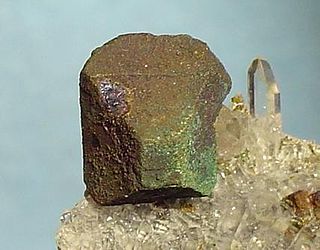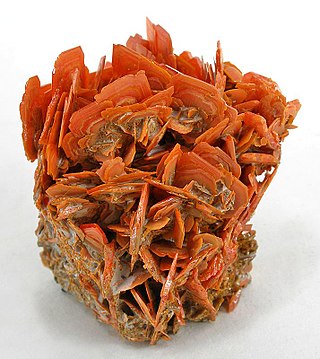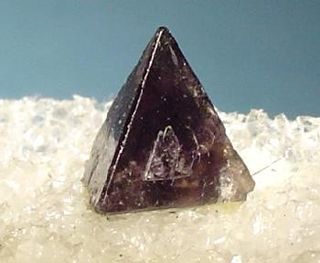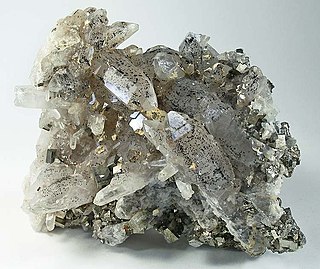
Germanite is a rare copper iron germanium sulfide mineral, Cu26Fe4Ge4S32. It was first discovered in 1922, and named for its germanium content. It is only a minor source of this important semiconductor element, which is mainly derived from the processing of the zinc sulfide mineral sphalerite. Germanite contains gallium, zinc, molybdenum, arsenic, and vanadium as impurities.

Bornite, also known as peacock ore, is a sulfide mineral with chemical composition Cu5FeS4 that crystallizes in the orthorhombic system (pseudo-cubic).

Wulfenite is a lead molybdate mineral with the formula PbMoO4. It can be most often found as thin tabular crystals with a bright orange-red to yellow-orange color, sometimes brown, although the color can be highly variable. In its yellow form it is sometimes called "yellow lead ore".

Murdochite is a mineral combining lead and copper oxides with the chemical formula PbCu
6O
8−x(Cl,Br)
2x (x ≤ 0.5).

Fukuchilite, Cu
3FeS
8, is a copper iron sulfide named after the Japanese mineralogist Nobuyo Fukuchi (1877–1934), that occurs in ore bodies of gypsum-anhydrite at the intersection points of small masses of barite, covellite, gypsum and pyrite, and is mostly found in the Hanawa mine in the Akita prefecture of Honshū, Japan where it was first discovered in 1969. It occurs in masses within the third geologic unit of the Kuroko type deposits within the mine.
Frankhawthorneite Cu2Te6+O4(OH)2 is a monoclinic copper tellurate mineral (space group P21/n) named after Prof. Frank Christopher Hawthorne (born 1946), University of Manitoba, Winnipeg, Canada. It was discovered at Centennial Eureka Mine, Tintic District, East Tintic Mountains, Juab County, Utah, in 1995. It has a leaf green color.

Ajoite is a hydrated sodium potassium copper aluminium silicate hydroxide mineral. Ajoite has the chemical formula (Na,K)Cu7AlSi9O24(OH)6·3H2O, and minor Mn, Fe and Ca are usually also present in the structure. Ajoite is used as a minor ore of copper.

Digenite is a copper sulfide mineral with formula: Cu9S5. Digenite is a black to dark blue opaque mineral that crystallizes with a trigonal - hexagonal scalenohedral structure. In habit it is usually massive, but does often show pseudo-cubic forms. It has poor to indistinct cleavage and a brittle fracture. It has a Mohs hardness of 2.5 to 3 and a specific gravity of 5.6. It is found in copper sulfide deposits of both primary and supergene occurrences. It is typically associated with and often intergrown with chalcocite, covellite, djurleite, bornite, chalcopyrite and pyrite. The type locality is Sangerhausen, Thuringia, Germany, in copper slate deposits.
Jarosewichite is a rare manganese arsenate mineral with formula: Mn2+3Mn3+(AsO4)(OH)6. It was first described in Franklin, New Jersey which is its only reported occurrence. Its chemical composition and structure are similar to chlorophoenicite. This mineral is orthorhombic with 2/m2/m2/m point group. Its crystals are prismatic or barrel-shaped. The color of jarosewichite is dark red to black. It has subvitreous luster of fracture surfaces and reddish-orange streak. This mineral occurs with flinkite, franklinite, andradite and cahnite.

Carrollite, CuCo2S4, is a sulfide of copper and cobalt, often with substantial substitution of nickel for the metal ions, and a member of the linnaeite group. It is named after the type locality in Carroll County, Maryland, US, at the Patapsco mine, Sykesville.

Penroseite is a rare selenide mineral with formula (Ni,Co,Cu)Se2. It has a gray-steel color and black streak with a hardness of 3. It is an isometric mineral, 2/m3. Penroseite was first discovered in 1925 in a Bolivian rhyolite. It was named for Richard Penrose (1863–1931), an economic geologist.

Arthurite is a mineral composed of divalent copper and iron ions in combination with trivalent arsenate, phosphate and sulfate ions with hydrogen and oxygen. Initially discovered by Sir Arthur Russell in 1954 at Hingston Down Consols mine in Calstock, Cornwall, England, arthurite is formed as a resultant mineral in the oxidation region of some copper deposits by the variation of enargite or arsenopyrite. The chemical formula of Arthurite is CuFe23+(AsO4,PO4,SO4)2(O,OH)2•4H2O.

Chambersite is a manganese borate mineral with formula Mn3B7O13Cl. It is a member of the borate mineral series that includes other minerals such as ericaite and boracite. When chambersite was first discovered, it was the second chemical analogue of boracite to be found in nature. It was discovered as a mineral at Barber's Hill salt dome in Texas in 1957 and in 1971 at the Dongshuichang deposit in Jixian, Tianjin, China. Chambersite occurs associated with the evaporite minerals halite, anhydrite, and gypsum.
Mooihoekite is a copper iron sulfide mineral with chemical formula of Cu9Fe9S16. The mineral was discovered in 1972 and received its name from its discovery area, the Mooihoek mine in Transvaal, South Africa.

Delafossite is a copper iron oxide mineral with formula CuFeO2 or Cu1+Fe3+O2. It is a member of the delafossite mineral group, which has the general formula ABO2, a group characterized by sheets of linearly coordinated A cations stacked between edge-shared octahedral layers (BO6). Delafossite, along with other minerals of the ABO2 group, is known for its wide range of electrical properties, its conductivity varying from insulating to metallic. Delafossite is usually a secondary mineral that crystallizes in association with oxidized copper and rarely occurs as a primary mineral.

Hemusite is a very rare isometric gray mineral containing copper, molybdenum, sulfur, and tin with chemical formula Cu6SnMoS8. It was discovered by Bulgarian mineralogist Georgi Terziev in 1963. He also described it and named it after Haemus, the ancient name of Stara planina (Balkan) mountains in Europe. The type locality is Chelopech copper ore deposit, Bulgaria. Later tiny deposits of hemusite were found in Ozernovskoe deposit, Kamchatka, Russia; Kawazu mine, Rendaiji, Shimoda city, Chūbu region, Honshu Island, Japan; Iriki mine, Iriki, Satsuma-gun, Kagoshima Prefecture, Kyushu Region, Japan; Kochbulak deposit, Tashkent, Uzbekistan. Hemusite occurs as rounded isometric grains and aggregates usually about 0.05 mm in diameter and in association with enargite, luzonite, colusite, stannoidite, renierite, tennantite, chalcopyrite, pyrite, and other minerals.

Ixiolite is an accessory oxide mineral found in granitic pegmatites. It is an oxide with the general chemical formula (Ta,Nb,Sn,Mn,Fe)4O8 or (Ta,Mn,Nb)O2.

Ferrimolybdite is a hydrous iron molybdate mineral with formula: Fe3+2(MoO4)3·8(H2O) or Fe3+2(MoO4)3·n(H2O). It forms coatings and radial aggregates of soft yellow needles which crystallize in the orthorhombic system.

The mineral hubeite, Ca
2Mn2+
Fe3+
[Si
4O
12(OH)]·(H
2O)
2, is a sorosilicate of the Si
4O
13 group. Structurally it also belongs to the Akatoreite group. It was found and named after the province of Hubei, China. It is common to iron ores in a mine of that region. It occurs mainly as aggregates of fan like crystals. It is dark to pale brown, has orange-brown streak and is vitreous. Hubeite has a hardness of 5.5 in the Mohs scale, one good cleavage and conchoidal fracture. It is triclinic with a space group of P1*. The structure of hubeite is very uncommon, and in fact there is only one other mineral that fits the Si
4O
13 group, which is ruizite.

Ferronickel platinum is a very rarely occurring minerals from the mineral class of elements (including natural alloys, intermetallic compounds, carbides, nitrides, phosphides and silicides) with the chemical composition Pt2FeNi and thus is chemically seen as a natural alloy, more precisely an intermetallic compound of platinum, nickel and iron in a ratio of 2:1:1.

















